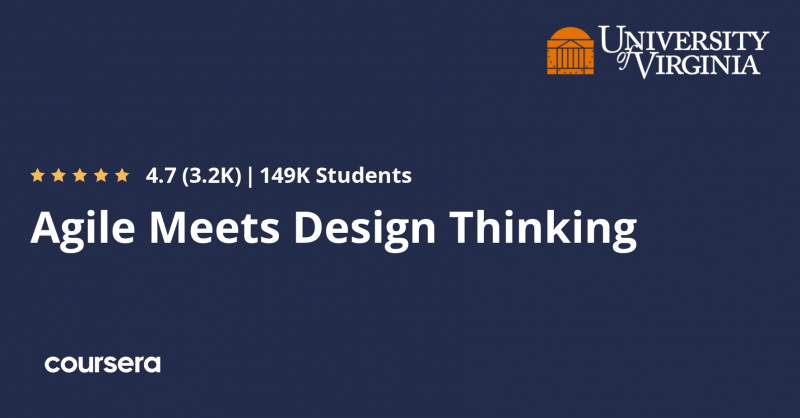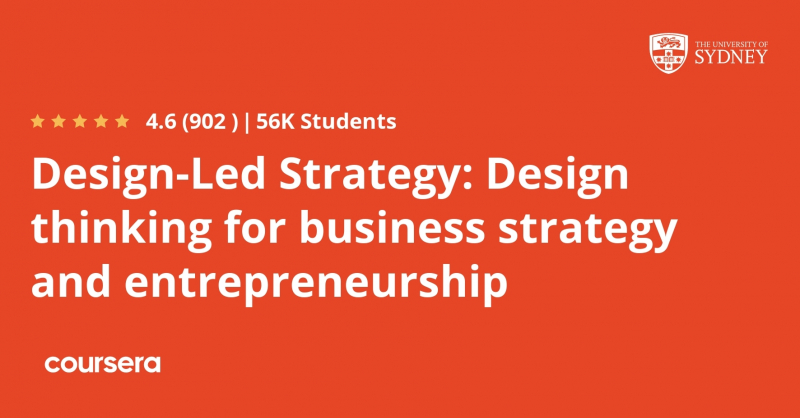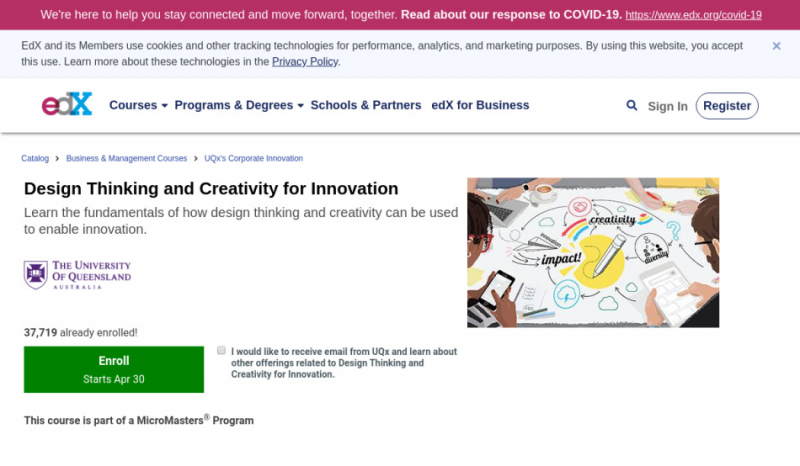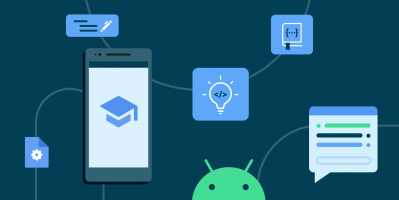Top 12 Best Online Design Thinking Courses
Design Thinking is a human-centered innovation methodology that fosters a focus on client needs in order to produce better goods, services, and internal ... read more...processes. It is applicable to all businesses, regardless of size, industry, stage of development, or geographical location. This is the ideal time to begin learning Design Thinking methodologies in order to stay nimble and ahead of the competition. Follow the list of top 12 best online design thinking courses that you should not miss.
-
Rochester Institute of Technology's Design Thinking Micromasters program on edX is another excellent option for mastering Design Thinking. The intensive curriculum of this program strives to teach learners how to be creative, collaborative, and emotionally savvy in their pursuit of problem-solving competence. It provides students with understanding of the procedures and tactics utilized in the workplace to solve problems and innovate.
This Design Thinking Certification program is divided into five six-week courses. Participants are required to invest 8-12 hours per week to the program and must successfully complete all five courses to earn a final Micromasters credential. The program's five courses cover the following topics:
- Design thinking fundamentals that inspire innovation and lead to user centred solutions
- Identifying and understanding product and business problems through active listening, empathy and user focus research
- Transforming the ideas into solutions through ideation and iteration
- How best to communicate your solution to stakeholders
- Iterated prototyping and user testing of solution before they go to market
- How to evaluate solutions post launch
- Demonstrating the knowledge and skills gained through the design thinking journey
Students are required to address a given problem using the design thinking method and tools learned throughout the curriculum in the final Design Thinking capstone project. After successfully completing this program, students can continue their education by enrolling to RIT for a master's degree in professional studies. They are given nine credits toward their master's degree at RIT for their MicroMasters credential.
Key Highlights
- Innovative program that offers flexible way to gain the most-in demand design thinking professional skills and advance career
- Designed for anyone who wants to add more creative and strategic thinking into their career, be it entrepreneurs, professionals who work in teams, executives, managers etc.
- Learn user-cantered research skills to gain user empathy through interviews and observations
- Acquire strategies to understand user context to identify and verify business problems
- Learn ideation and visualization techniques to generate targeted and creative solutions
- Learn methods for evaluating and applying user feedback from testing models and prototypes to identify preferred solutions
Duration : 7-8 months, 8-12 hours per week
Google Rating : 4.7/5.0
Enroll here: edx.org/micromasters/design-thinking

edx.org 
edx.org -
This Design Thinking Program was created by HEC Paris, Europe's number two business school. It is available on Coursera as part of a stackable degree program called the MSc in Innovation and Entrepreneurship. As a result, students can begin their degree by enrolling in this speciality. If they are accepted into the full degree program, the courses will be applied toward the degree. Learners can also pursue this specialization without enrolling in the degree program.
This specialization teaches students how to apply design thinking and creativity in daily business processes. Students learn how to drive innovation at each stage of business development, from idea generation to company leadership. They are taught a variety of organized models and approaches that will assist them in becoming an innovator and change-maker in any business. The four basic courses listed below are at the heart of this Design Thinking specialization. To receive a certificate of completion, students must complete these four courses as well as a hands-on final project.
- Boosting Creativity for Innovation – This course helps learners to develop creative abilities and acquire a set of strategies that enable them to tackle business problems with a fresh perspective.
Strategic Management of Innovation – This course prepares learners for making strategic decisions specifically about innovation. - Organizational Design and Management – This course covers theoretical and applied frameworks that help learners to better design and manage their organization.
- Design Thinking – This course discusses a systematic approach to unlock creative insights and innovative solutions in situations where analytical approaches are ineffective.
This program provides a comprehensive examination of four applicable case studies of successful ventures. It is ideal for entrepreneurs, managers, and business leaders who want to learn how to develop and manage a team, project, or organization.
Key Highlights
- Highest rated Coursera Design Thinking program
- Understand what is design thinking, its foundations, principles and main phases
- Understand why firms innovate, why and how they compete on innovation, and the role of innovation in shaping the strategic decisions of companies
- Build your own prototype for a product, service, or business design
- Learn to evaluate the value-creating potential of your business idea and design the business model that is best suited to capturing this value
- Understand the diffusion of design thinking in established firms
- Develop a personal tool-box and managerial framework to effectively foster creativity in your organization
Duration : 5 months, 6 hours per week
Coursera Rating : 4.7/5.0
Enroll here: coursera.org/browse/business/leadership-and-management

twitter.com 
classcentral.com - Boosting Creativity for Innovation – This course helps learners to develop creative abilities and acquire a set of strategies that enable them to tackle business problems with a fresh perspective.
-
Agile and Design Thinking combined can create a very innovative and effective approach to product development. This Darden School of Business Course explains how to use agile product development and design thinking to deliver valuable answers to important challenges and create better digital goods. Students in this course learn how to decide what is valuable to a user early in the process, how to focus most of their efforts and time on testable narratives about the user, and how to create a strong shared perspective. The course is divided into four modules that cover the following topics:
- Overview of Agile practices and the problems agile solves
- Developing personas, problem scenarios, and alternatives using best practices from design thinking
- User research
- Creating agile user stories
- Testing assumptions
- Focusing on Customer Value with User Stories
This course is best suited for those who have some experience working in the digital arena and use agile approaches. It is part of the Coursera specialties Digital Product Management Specialization and Agile Development Specialization. Alex Cowan, a former entrepreneur and intrapreneur, teaches the course. He is currently teaching and coaching product teams at UVA Darden. His specialty is in digital innovation.
Key Highlights
- Agile and Design Thinking Course endorsed by Project Management Institute (PMI)
- Learn to evaluate and explain the relevance of concepts and practices from the agile development methodologies
- Learn to use design methods like personas and problem scenarios
- Understand how to facilitate narrative collaboration with user stories and prototypes
- Learn how to diagnose what software will be valuable to the user and how to test your ideas using agile user stories and prototypes
Duration : 4 weeks, 2-5 hours per week
Google Rating : 4.7/5.0
Enroll here: coursera.org/learn/uva-darden-getting-started-agile
coursera.org -
This Design Thinking Course was created at the University of Virginia's Darden School of Business and is delivered by world-class academics. It is one of the best online Design Thinking courses. Design Thinking entails procedures and a collection of tools that assist them in being innovative and creatively successful. This course revolves around these processes and toolkits, as well as their use in organizational settings.
This Design Thinking course is appropriate for anyone who has a problem and would like to learn a creative way to fixing that problem. The students use a methodology that includes four essential questions and many tools to help them grasp design thinking as a problem-solving strategy.- What is going on today
- In an ideal world what would they like to create tomorrow
- What will really work for the people who help you create it
- What happens when they actually try out a small experiment in the marketplace to see what works
Participants learn a set of tools associated with these four questions, which collectively help them become inventive thinkers. The course also covers several case studies from other firms that employed design thinking to find appealing solutions. The course concludes with a final assignment that requires students to choose one of the design thinking tools covered in the course, write a reflection, and complete three peer reviews.
Design Thinking is best learned through practice. As a result, this course encourages participants to identify an opportunity or problem in their company or personal lives that they would like to tackle and then work toward it as the course unfolds. Darden School of Business is a pioneer in creative online learning, and its services are an essential component of the greatest business school experience in the world. Jeanne M. Liedtka, the course instructor, is a highly distinguished professor and former chief learning officer at United Technologies Corporation. She has conducted extensive study in the field of Design Thinking and has written several bestselling books on the subject.Key Highlights
- Most popular Design Thinking Course on Coursera with maximum student enrolments
- Understand what design thinking is and when to use it and how to use the Visualization tool
- Learn to use design thinking to generate innovative ideas and how to use the Mind Mapping tool
- Understand how to take the many ideas you generate and determine which ones are likely to produce specific, desired outcomes
- Abundance of case studies, readings, and activities that help learners uncover creative thinking, innovation and opportunities
- Learn how to prepare to see and take action when opportunity arises and how to use the Storytelling tool
- Understand how to use the Learning Launch tool
Duration : 4 weeks, 2-3 hours per week
Coursera Rating : 4.7/5.0
Enroll here: coursera.org/learn/uva-darden-design-thinking-innovation

coursera.org 
slideshare.net -
IDEO is a company that has become synonymous with design thinking. David Kelly (also the founder of Stanford's d.school) created it, and he pioneered the essential notion of user-centered design. Through two cohort courses, Insights for Innovation and From Ideas to Action, IDEO U's Design Thinking Certification program teaches the basic skills and mentality of design thinking.
Each of these courses is 5 weeks long, and students must finish both to receive their final certificate. They can, however, take either or both of these courses separately. These IDEO courses provide a hands-on learning experience. By the end of this program, learners not only have a deeper understanding of their clients' social, emotional, and physical requirements, but they are also able to apply the methodologies and tactics to turn those needs into human-centered solutions.
Insights for Innovation, the first course, focuses on the first phase of design thinking, which is identifying customer needs. It covers the following topics:- Developing empathy for your customers
- Identifying extreme people to observe and interview
- Planning and conducting great customer interviews
- Creating a compelling narrative about insights gained that will inspire and motivate others to innovate
The second course, From Ideas to Action, dives into the design thinking skills of ideation, prototyping, and iteration. It covers the following major topics:
- Ideation methods and techniques for coming up with an abundance of innovative ideas
- 3 Steps for Prototyping—Build, share, and reflect
- Gathering feedback, and getting to better solutions faster
- 4 Steps to Iterate—Managing risk and refining your ideas
- Running small experiments to learn from failure in a controlled environment
Key Highlights
- Gain foundational and practical understanding of the essential design thinking skills and mindsets
- Learn to use ideation techniques to quickly generate, develop, and test new ideas
- Learn how to de-risk your new ideas by gaining feedback through rapid prototypes
- Opportunities to try the skills learnt through real-world project challenges
- Taught by instructors who are subject matter experts and have led thousands of design projects across the globe
- A lot of focus on sharing and discussing ideas with a global peer network to enhance understanding
- A variety of reflective activities to help learners make the connections to their specific work challenges
- Self-paced courses with no deadline for certificate completion
Duration : 2-3 months, 4 hours per week
Google Rating : 4.6/5.0
Enroll here: ideou.com/collections/design-thinking-courses/products/design-thinking-certificate

ideou.zendesk.com 
ideou.zendesk.com -
The Batten Institute for Entrepreneurship and Innovation at the University of Virginia's Darden School of Business created this Course. It is aimed at those who work in the nonprofit or social sector and are looking for insights into effective approaches for identifying and solving problems that society faces today. Often, social service organizations struggle to meet the demands of the people they serve and are unable to find new and inventive solutions to difficult situations. This Design Thinking training demonstrates how and why human-centered design is an effective technique for addressing such issues. This course covers design thinking ideas that can assist to reframe challenges, ideate potential solutions, and iterate towards better answers, whether you work in education, health care, or government - at any organizational level.
Design thinking is rapidly being used in the social sectors around the world to address difficult educational, medical, agricultural, security, and transportation concerns. Such tales are shared in this course to demonstrate how collaborative creativity can assist even the most entrenched bureaucracy arrive at novel solutions. It explains to managers why including design thinking in their organization's arsenal is critical for success.This four-module course is organized around four questions: what is, what if, what wows, and what works. Each lesson focuses on the skills, processes, and mentality required to employ design thinking to unearth innovative and creative social solutions.
Key Highlights
- Learn what design thinking is and how to use it to address major social issues
- Prepare to see and take action when opportunity arises
- Learn to understand the problem you’re trying to solve, generate testable ideas and make small bets quickly
- Understand how to take the many ideas you generate and determine which ones are likely to produce specific, desired outcomes
Duration : 4 weeks, 2-4 hours per week
Google Rating : 4.6/5.0
Enroll here: coursera.org/learn/uva-darden-design-thinking-social-sector

coursera.org 
classcentral.com -
The University of Sydney is offering a free intermediate level Design Thinking course on Coursera. It is aimed at entrepreneurs and managers from a variety of industries who are looking for tools and approaches to help them bring innovative products or services to their clients. The ideas and approaches presented in this course can assist all companies, from small and medium-sized businesses to corporations.
This course discusses the issues of intra-organizational friction or group mentality that prevent various brilliant ideas for new goods from coming to life. It expands on the fundamental principle of design thinking in order to promote business strategy and entrepreneurship. It teaches what ‘design strategy’ is, how it differs from traditional design thinking and business strategy, and how it can be used to improve existing or introduce novel products and services. There are 5 weekly modules in this course that cover the following topics:- Introduction to design-led strategy
- Elements of corporate strategy
- How to plan and conduct primary market research and analyse the results gathered
- Problem statement definition
- Usable models and frameworks for gathering user feedback and testing solutions
- Prototyping and product ideation
- Corporate case studies
This course offers two practical case studies of two of Australia's most innovative financial organizations, UBank and Swiss Re, on how they use design strategy to innovate and address challenges on a daily basis. These shed light on the practical implementation and impact of design thinking methodologies.
Key Highlights
- Highly-rated and popular free Design thinking course on Coursera
- Gain a set of tools to inform product design and development for your start-up or organization
- Learn the practical application of design thinking to overcome organizational roadblocks
- Be able to use design strategy in your own business context
- Corporate case studies provide meaningful insights into impact of design strategies on an organization’s success
- Multiple quizzes and exercises and supplemental reading materials at the end of each section
Duration : 5 weeks, 3-5 hours per week
Google Rating : 4.6/5.0
Enroll here: coursera.org/learn/design-strategy

fr.coursera.org/learn/design-strategy -
LinkedIn Learning has a large selection of online Design Thinking courses. These courses teach students about the theory and techniques of design thinking, as well as how to use them to better understand users and develop creative solutions. These Design thinking workshops are aimed at encouraging solution-based problem resolution and creativity inside enterprises.
The design thinking industry is not limited to a single job description. Thousands of learners from all sectors and jobs have benefited from these courses, which have trained them in the necessary concepts, approaches, and toolkit to design user-centered, sustainable, and effective solutions. The majority of these courses are brief, beginning to intermediate level, and do not require any prior knowledge. They were developed by industry leaders and academics with extensive expertise. Here are some of the greatest design thinking certificate courses available on LinkedIn Learning:
Design Thinking: Understanding the Process
- By: Chris Nodder
- Duration: 41m
- This coures discusses where design thinking fits into product development and what it can help you achieve. Each step in the process is described in detail, from identifying the problem you want to solve and brainstorming solutions, to prototyping, development, and release.
Learning Design Thinking: Lead Change in Your Organization
- By: Turi McKinley
- Duration: 2h 8m
- This course teaches how to be a good design thinking leader and engege in creative collaboration. It covers planning, research, and concept creation, and explains how to create a “service blueprint” that will help make the design a reality.
Design Thinking: Customer Experience
- By: Geoffrey Schwartz
- Duration: 34m
- This course introduces learners to customer experience and why it’s important. It teaches foundational tools needed to take a holistic view of an organization’s customer experience and identify opportunities that can deepen relationships and drive loyalty.
Design Thinking: Implementing the Process
- By: Chris Nodder
- Duration: 46m
- This course teaches how to implement a design thinking process at your company. It follows along with a sample project—a trail maintenance app—which is turned into a testable concept and full-featured product.
The Five-Step Creative Process
- By: Stefan Mumaw
- Duration: 19m
- This course guides learners through the five steps of design thinking process and then shows what the complete process looks like, with a real-world project of designing a website.
Design Thinking: Prototyping
- By: Randall Elliott
- Duration: 58m
- This course teaches how to use prototyping to make better decisions, use those design decisions for the next steps, and make sure those steps lead to great experiences
Key Highlights
- Well designed short courses in design thinking from expert educators
- Learn Design Thinking principles and tools and how to use them to solve complex problems in business and even personal lives
- A range of exercises, quizzes, assignments included for hands on practice of the concepts taught
- Courses and study materials available for free as part of 1 month trial membership
- Flexible timelines and self-paced mode of learning
- Good fit for those who are new to design thinking or looking for a refresher course
Duration : Self-paced
Google Rating : 4.5/5.0
Enroll here: linkedin.com/learning/topics/design-thinking

classcentral.com 
classcentral.com -
Organizations frequently face difficulties in fostering and managing innovation. This edX course from the University of Queensland teaches how to build and capture value from innovation. It investigates how individuals and organizations may utilize creativity and design thinking skills to identify and select possibilities for innovation. It teaches the Design Thinking process and tools and helps students learn how to apply design thinking as a problem-solving technique. This Design Thinking course is part of the Micromasters in Corporate Innovation program. It consists of ten weekly sessions covering the following themes.
- The fundamental concepts of creativity, design and innovation
- Creativity myths and why they’re dangerous
- Ideas and tools that foster creativity and can help people and organisations work more creatively
- How to measure impact and the value created through creativity
- Design Thinking process and tools for innovation and role of empathy in the design thinking process
- How do you learn what fits people’s needs
- Designing and executing experiments for value creation
- Principles of a design sprint and how to make it happen
- Concept of distributed creativity and how diversity and collaboration through networks support the creativity process
- Show how organizations can create impact from ideas
The course also contains various real-world tasks that help participants build and improve their creative problem-solving skills. Tim Kastelle, Director of Entrepreneurship & Innovation and Associate Professor of Innovation Management at UQ Business School, will teach the course. Tim has vast experience in innovation management and has published extensively in prominent innovation publications.
Key Highlights
- Learn how creativity and design thinking can help businesses solve complex problems
- Explore different creativity and design processes and how they can be used to generate better ideas
- Learn to apply ideas to a customer discovery approach to understand their value in the market place
- Learn how to use a variety of tools to help validate your ideas to improve their chances for impact
- Learn to use design sprints to integrate the different elements of the course into a systematic method for generating and testing new ideas
- Self-paced course that can be taken at your own time
- Course available for Free. Can add a verified certificate at a small fee.
Duration : 10 weeks, 8-10 hours per week
Google Rating : 4.5/5.0
Enroll here: edx.org/course/design-thinking-and-creativity-for-innovation

iblnews.org 
iblnews.org -
IBM was an early proponent of Design Thinking. The organization has implemented design thinking ideas across many disciplines and even provides free online design thinking courses based on its own expertise. IBM's approach to applying design thinking at the pace and scale required by a modern organization is known as Enterprise Design Thinking. The organization thinks it assists teams in not only forming intent, but also delivering innovative solutions that enrich the lives of those they serve. The courses now available range from short and specialized (a few hours) to intensive (a 3 to 6 weeks team-based lessons):
- Practitioner – This is a 2 hours design thinking class that will give you a baseline of Enterprise Design Thinking skills: collaboration, synthesis, design research, prototyping, and storytelling.
- Co-Creator – This is a three to six weeks series of practice based modules will help you work on methods like identifying stakeholders, creating a research plan, and testing ideas.
- Team Essentials for AI – This course is based on IBM’s AI Essentials Framework. It teaches the framework and tools you need to recognize responsible AI design, align your team, and work with data sources to start building an AI solution.
All of IBM's courses and toolkit activities are presently available for free. To get started, all that is required is the creation of an account.
Key Highlights
- Learn to apply design thinking to complex teams, problems, and organizations
- Understand how to drive business results by focusing on users’ needs
- Learn to build alignments and collaboration across the teams for better results
- Learn to create a research plan and synthesise research
- Learn to build detailed prototypes and refine them through feedback
- Create a shared vision with your team
- Learn from examples in practice
Duration : Self-Paced
Google Rating : 4.4/5.0
Enroll here: ibm.com/design/thinking/

ibm.com 
ibm.com -
Alan Cooper, a world-renowned educator, designer, and author, and his team at Designit Strategic Design created this Udemy Design Thinking Course. It is a best-selling course on Udemy, with over 57,000 students having registered. This course presents a distinct method to problem solving that learners can use to create memorable client experiences. Students learn to take a human-centered approach to innovation and gain access to a powerful collection of tools that will help them become more collaborative, innovative, and effective. This Design Thinking class divides the learning into three sections:
- Understand – How to better understand problems from customer perspective
- Envision – How to brain storm out of the box, innovative ideas
- Prototype – How to create prototypes to test your ideas before investing a lot of time and money
This is a wonderfully dynamic course that doesn't only teach design theory; it swiftly moves on to how to accomplish it, with plenty of experience. Students work on a real-life project from inception to finish, which allows them to apply goal-directed Design abilities. This workshop is appropriate for a wide spectrum of professionals, managers, designers, business leaders, and entrepreneurs who wish to break free from the conventional ways of solving problems. It is ideal for those who want to update and reinforce their knowledge of design thinking.
Alan Cooper is a pioneer in UX design and his team comprises of highly competent designers and educators. The majority of the course is taught by Teresa Brazen and Sanskriti Ayyar. Alan teaches some of the lectures, offering his perspective on each of the key phases of the design thinking process.
Key Highlights
- Learn about design thinking while working on a real project
- Understand how to plan and conduct effective design research, including user interviews
- Learn how to understand problems from the audiences’ perspective
- Learn to create and use a storyboard to communicate your design ideas
- Learn to make a plan to iterate your idea forward
- Learn to create prototypes to test your idea early, before making a big investment of time and money
Duration : 1.5 hours on-demand video
Udemy Rating : 4.4/5.0
Enroll here: udemy.com/course/designit-design-thinking/

wiprodigital.com 
hasilcopa.com -
This is a one-hour video course on Udemy that introduces the principles of design thinking and how they may be applied in businesses and organizations. It teaches the five-step human-centered problem-solving process. This course begins with an introduction to design thinking, followed by an in-depth look at each step of the design process, and concludes with an explanation of storytelling and why storytelling is useful in attempting to implement design thinking in organizational settings. It focuses on the following topics:
- Why design thinking matters
- How to empathize with your users through interviews and observations
- Synthesis Frameworks to help define your core problem by synthesizing and analyzing information gathered
- Tips and Tricks to ideate solutions to your problem by brainstorming
- Prototyping ideas rapidly to identify the best possible solution for your problem
- Testing a Hypothesis with users to gather feedback on proposed solution
- Using storytelling to pitch design thinking to your team or organization
Students complete a real-world design project as part of the course. There are numerous activities that accompany each lecture that allow students to apply each phase of the process to an example design challenge. Students receive access to a workbook that contains all of the templates they'll need to finish the design assignment. Laura Pickel is the creator of this course. For several years, she has used and taught design thinking at firms such as SAP, IDEO U, Stanford Design School, and others.
Key Highlights
- Understand how to apply the 5-step design thinking process to a design challenge in your organization
- Learn to empathize with your user through interviews and observations, in order to take a human-centered approach to a problem
- Learn through practical application by solving a design challenge of your choice
- Suitable for professionals from a wide range of roles like business managers, HR employees, product managers, designers who are looking to use design thinking to discover and implement best solution to problems
- Great fit for those who want a refresher in the core concepts of design thinking
Duration : 1 hour on-demand video
Udemy Rating : 4.3/5.0
Enroll here: udemy.com/course/design-thinking-for-beginners

np.linkedin.com
































